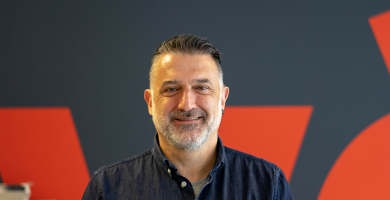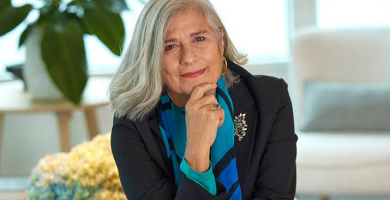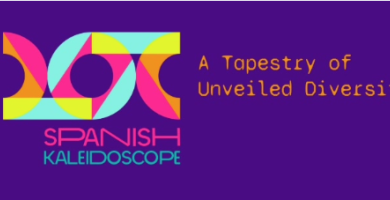
Joan-Lluís Ramisa: "Discovering older or less well-known films allows the people of Barcelona to discover another Barcelona."
This month we interview Joan-Lluís Ramisa, in charge of film programming at betevé and therefore of the cycle Barcelona…i acció. We talk with him about the cycle and the films that it shows, always shot in our city.

You are a film programmer in betevé. What does your work consist of? And how did you come to this position?
Basically, my work consists of finding and programming films which are set in Barcelona. I studied film in Great Britain and I have always been a great film-lover. I was already working in betevé as a producer when my predecessor stepped down and, given my profile, they approached me about being in charge of the film programming. And I gladly accepted.
For you, what is most interesting about this work?
The work has a detective part which I like a lot, which involves constantly searching for films from all periods which were shot in Barcelona. The most interesting for me is when I find relatively unknown films, since this gives me the opportunity to present them to our viewers. This is maybe the part that I enjoy the most.
And what is the most difficult part?
When I have located relatively unknown films, finding out who has the rights and how I can obtain them. And, sometimes, there is also the problem of the material, if they are old films, which maybe have not been remastered and are not of broadcasting quality.
How and when was the cycle Barcelona…i acció created?
The cycle was created in 2010 with the idea of showing Barcelona as a film set and being able to see how the city has been reflected on the screen. I believe that this is part of the dissemination task that we have to undertake as a public television company. As part of our public service philosophy and, above all, within its cultural dimension.
Is there any film which you wanted to show and which it was impossible to find or with which you encountered great difficulties?
As I mentioned, the difficulties usually involve finding who has the rights for relatively unknown films. Then, also, due to budget issues. We have a modest budget which does not always allow us to purchase the rights of, above all, more recent films. I have some films pending which we have not yet been able to show for one of these reasons, such as, for example, Vicky, Cristina, Barcelona, Biutiful or The Consul of Sodom.
When you confront a new season of the cycle, what criteria do you use to programme?
There are different criteria. One is obviously the cinematographic quality of the film. And, also, the fact of being able to programme films from all periods, so that you can see how Barcelona has been reflected in the different decades in which films have been shot in the city. Therefore, we always seek these two things: quality and, at the same time, also variety, as regards both subject matter and periods.
Is Barcelona well-represented in film?
I think so, quite well, because many directors have shot in our city, each with a different sensitivity and explaining very diverse stories. This has allowed us, through film, to be able to see many different Barcelonas depending on the sensitivity of each director.
How has the city’s image evolved over the years in film?
It has evolved a great deal. In the 50s and 60s, when the so-called Barcelona crime films began, Barcelona was the setting of crime plots, but over the years we have been able to see how other views of the city have gradually been incorporated, some more touristy and other more comical, but it has definitely changed. Barcelona has even been the setting for science fiction films. This did not occur years ago.
One of the fundamental elements of the film commissions is the locations. We have our directory, for example. You always offer an introduction to each film in its locations. How do you choose these locations? Do you follow any criterion on choosing them? Whether they are indoor or outdoor, whether or not the city is recognized?
For each film we make a detailed list of the locations that appear. Despite the fact that we mention them all, when we are going to record, we choose certain specific ones. When it comes to choosing those that we will use for the introductions, we always tend to prioritize exteriors because that is the best way in which the viewer can recognize the city. And also, from among these, those which are more important for the plot. I mean that, if they are locations in which a more important scene takes place, then we prioritize them. Despite the fact that, obviously, we also use indoor locations, the majority are outdoor.
In some films, above all old ones, it may even be difficult to find exactly where they were shot.
The oldest ones are the most difficult to find. First, because there is very little information about the locations. Nowadays, the majority of films already give you clues in the credits about where they were shot, when they are not very evident. With the oldest ones, this is part of the detective work that we were talking about earlier. Not just finding them, but also viewing them and searching for the locations which were used when they are not obvious. The streets and the places. It is a bit like using a magnifying glass. Above all, with the oldest films, because Barcelona has changed a lot in recent years. I find places which have disappeared, for example. But, even so, we still go to the current location to contextualize a little how this location is shown in the film and what it is like now.
There are films which were shot here but which do not represent Barcelona, such as The Castle of Fu Manchu, or Barcelona might be Havana, for example. Which places would you highlight which have been other cities in Barcelona? Is the city disguised well or is it too recognizable?
Here it depends a great deal on the locations which are used. Obviously, the case of The Castle of Fu Manchu is quite paradigmatic, since the Parque Güell and the Parque de la Ciutadella represent Istanbul. Maybe the most notable case is Perfume, which transformed Barcelona into 18th-century Paris. I believe that this is maybe the most obvious example in which Barcelona was disguised, in this case as Paris. In Voyage of the Damned, they converted the port of Barcelona into the port of Hamburg and also the port of Havana, and Plaza Real into a location in the old quarter of Havana. In my experience, this does not occur a lot, but there are some cases such as these, in which Barcelona was used to represent other places.
Which places in Barcelona do you think are the most cinematographic? In the end, maybe it is where they shoot the most, because they are the most recognizable.
Possibly, the Rambla and its surrounding area is one of the places which have been used the most. Personally, I think that the streets of the Gothic Quarter and of the Raval are the most cinematographic, because they have their own personality which often helps the plot. Despite the fact that I appreciate it when a film moves away from the centre of Barcelona and shows other less frequented locations: neighbourhoods such as Clot, Poble Nou and Sants, which have not been used so much. This also highlights other places which are not the most typical and, possibly, the most touristy, such as the Rambla, the Sagrada Familia, Gaudí,...
Now Poble Nou is an area in which films are shot a lot, for example, whereas they were not before.
Recently films are being shot there a great deal. But, over all these decades of films shot in Barcelona, it is only in the last 20 years that Poble Nou has begun to be shown as a cinematographic element. But, anyway, when we go to shoot our introductions, we are fed up with going to the Rambla, Plaza Real and all these places, because they are among those which have been used the most.
Which films would you highlight? Or, rather, which films have made you discover a Barcelona that you did not know and maybe you had not previously seen?
I would choose many of the fundamental titles of the crime films of Barcelona, such as Apartado de correos 1001 or A tiro limpio. In many of the films shot in the 50s and 60s, as I was saying earlier, because Barcelona has changed a great deal, a Barcelona is shown which has disappeared or changed greatly. Cases such as Young Sanchéz, Los Tarantos, Los cuervos or El ojo de cristal, or even Fata Morgana, have been films which have shown me a very different Barcelona to the one that we know. And, as I have already told you, often what they show does not exist any more or has changed a great deal.
You began the new season of Barcelona...i acció with Fanny Straw Hair. How are you confronting this new season?
With plenty of enthusiasm. In 10 years of cycles, we have always sought the cinematographic quality of the films, following the line of trying to get the cycle to reflect all periods, not just the most recent films, because possibly the most recent films are those that people are most aware of. On the other hand, discovering older or less well-known films allows the people of Barcelona to discover another Barcelona.
You have also shown a true classic, A tiro limpio by Francesc Pérez Dolz.
Yes, it’s incredible. We moreover had the opportunity to interview the director, when he was already very old, before he died, and he explained many anecdotes to us. Of course, it was a time when there were no means and he had to invent many resources in order to be able to make the film that he wanted. He even had a crane built for certain specific needs of one scene, and this crane was then patented and used to make films.









